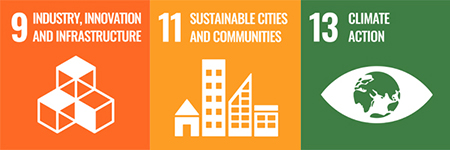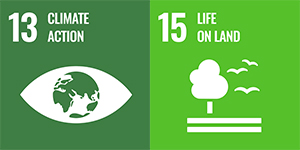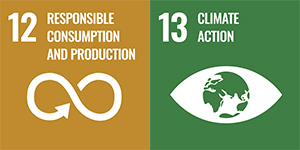![Polar bear sow and cub walk on ice floe in Norwegian arctic waters [Photo: Shutterstock]](https://cfmnsugzia.cloudimg.io/www.gla.ac.uk/media/Media_795504_smxx.jpg?width=2000&force_format=webp)
Spotlight on climate change research
UofG projects that are making a difference
At UofG, we’re not just talking about reversing climate change – we are taking action. Our research into tackling global warming, pioneering green technology and promoting sustainability is world leading, and the COP26 climate change conference being hosted in Glasgow this November will present even greater opportunities for us working together to find climate solutions. We align our research with the United Nations' Sustainable Development Goals – 17 objectives adopted by all UN member states in 2015 as part of a 15-year plan of ambitious action. They are a blueprint for all countries to end poverty and bring peace and prosperity to the planet.
Here is just a small selection of our recent research activities that are making a difference, along with the SDGs that each one addresses.
Letting nature heal itself
Could allowing nature the chance to regenerate be the best solution of all to climate change? UofG professors Nick Hanley and Larissa Naylor have co-authored a report by the COP26 Universities Network on how working with nature can benefit people, biodiversity and the planet, and could address many of the critical environmental challenges that we face.
When we think of nature-based solutions, large-scale tree-planting may be the first thing to come to mind; however, the report stresses the role of marine habitats and the crucial need for biodiversity. “Nature-based, green engineering projects like the enhancement and protection of coastal landforms including saltmarshes and sand dunes, must be placed at the heart of long-term investment strategies,” says Larissa.
In the UK, environments such as peatlands, arable landscapes and urban green spaces all have the potential to deliver nature-based solutions. While not a substitute for the overriding priority of reducing fossil fuel consumption, these schemes to capture carbon and increase biodiversity have huge potential in tackling the climate crisis.
The report suggests the creation of novel habitats in urban areas. At UofG, we constructed green screens – fences made of ivy which can trap pollutants and reduce flooding risk – as part of our campus development. The result is a reduction of up to 40% of particulate matter in the air.

Our climate action timeline
- In 2014, we became the first university in Europe to commit to fully divesting from fossil fuel industry companies. Our aim is to complete this transition by 2024.
- In 2017, we endorsed the UN’s Sustainable Development Goals Accord, committing us to combatting poverty and climate change and to promoting peace and justice.
- In 2019, we became the first university in Scotland to declare a climate emergency, affirming our belief in the need for urgent action to address climate change.
- In 2020, our Centre for Sustainable Solutions was launched. The centre aims to position the University at the forefront of the worldwide movement to tackle the climate crisis.
- In 2021, the COP26 international climate change summit will be held in Glasgow. This will be a huge opportunity to showcase our sustainability research and develop new partnerships.
- 2030 is our target date for achieving net-zero carbon emissions by undertaking five key sets of climate actions to offset our carbon footprint both at home and overseas.
Learning from the past
Archaeology may not be the first discipline that comes to mind when we think of how to tackle the climate crisis, but a worldwide team of academics, co-led by Dr Nicki Whitehouse from the School of Humanities and colleagues from the US and Spain, is showing what archaeology can teach us about the role humans have played in contributing to global climate change. Their project, LandCover6K, looks back at 12,000 years of history to show how land use and land cover have changed globally, to improve our understanding of historical and current land-cover changes and their effects on climate. This could help us predict future effects and inform sustainability strategies, including the use of traditional agricultural practices.
The project aims to collect archaeological and historical evidence of land-use systems from 12,000, 6,000, 4,000 and around 600 years ago, and is also gathering fossil pollen records from lake sediments and peat deposits to establish how changes in land use have contributed to the loss of vegetation systems over time. “This incredible archaeological resource of information not only helps us understand these past activities,” says Nicki, “but also helps us to understand how humans continue to impact our global climate systems into the future.”

Greening food production
The Haber-Bosch process revolutionised food production in the early 20th century by scaling up the production of ammonia, which is vital in fertiliser manufacturing, until the food grown in this way became enough to feed 40% of the world’s population. Now, however, work is underway by a team led by Glasgow chemists to enable ammonia to be made without using fossil fuel sources. The project aims to find new catalysts that will make the Haber-Bosch process more efficient; at the moment, it consumes around 2% of the world’s energy output and produces a similar proportion of its carbon dioxide emissions.
Lead investigator Professor Justin Hargreaves of the School of Chemistry says, “For almost a century now, the Haber-Bosch process has helped us meet the nutritional needs of an expanding global population. If a step change in the catalyst performance was achieved, people in remote locations or in the developing world could make ammonia on a localised scale using hydrogen produced by electrolytic splitting of water, using electricity generated from solar or wind energy.”
Advanced computer modelling will allow the researchers to predict how new catalysts might work.

Batteries from vegetables
Nearly all of us take owning a mobile phone for granted. But the damaging effect of their lithium-ion batteries on the environment are notorious – the toxic chemicals used in their production can harm soil and water, food production and wildlife.
What if we could make these batteries from vegetables instead? A Glasgow-led team of engineers are working on making this a reality using materials such as corn, sugar cane and sugar beet to make more sustainable lithium-ion batteries capable of storing and delivering power more efficiently.
Principal investigator Dr Shanmugam Kumar from the James Watt School of Engineering says, “Lithium-ion batteries have their own sustainability issues, so it’s important that we look to find new ways to make them better and more environmentally friendly.”
Starch from the vegetables is made into electrodes which renders the batteries more readily recyclable and they are 3D-printed. The batteries are also lightweight, compact and able to withstand repeated charging, making them ideal for mobile phones, laptops and potentially also electric vehicles.

Pioneering sustainable fashion
We are finding ways to bring sustainability to an area of life that is traditionally “throwaway” – clothing consumption. Currently, UK citizens buy more new clothes than anywhere else in Europe and throw away over a million tonnes of clothing each year.
Professor Deirdre Shaw and Dr Kat Duffy from the Adam Smith Business School are researching consumers’ approach to clothes buying and promoting more sustainable ways of owning and wearing the clothes we already have.
One of these ways is by using the Save Your Wardrobe app. This takes a user’s clothing collection and digitises it so they can easily view, organise and make the most of the wardrobe they have. New, sustainable behaviours such as repairing, customising and upcycling are encouraged, and Kat and Deirdre offer a list of simple ideas to support ethical consumption and the circular economy:
- rewear
- repair before you replace
- buy pre-loved
- shop small and local
- buy with longevity.
“The latest must-have item can all too quickly become devalued,” says Deirdre. “Consumption impacts are significant, and we need a circular approach where resources are kept and used for longer.”

This article was first published June 2021.

